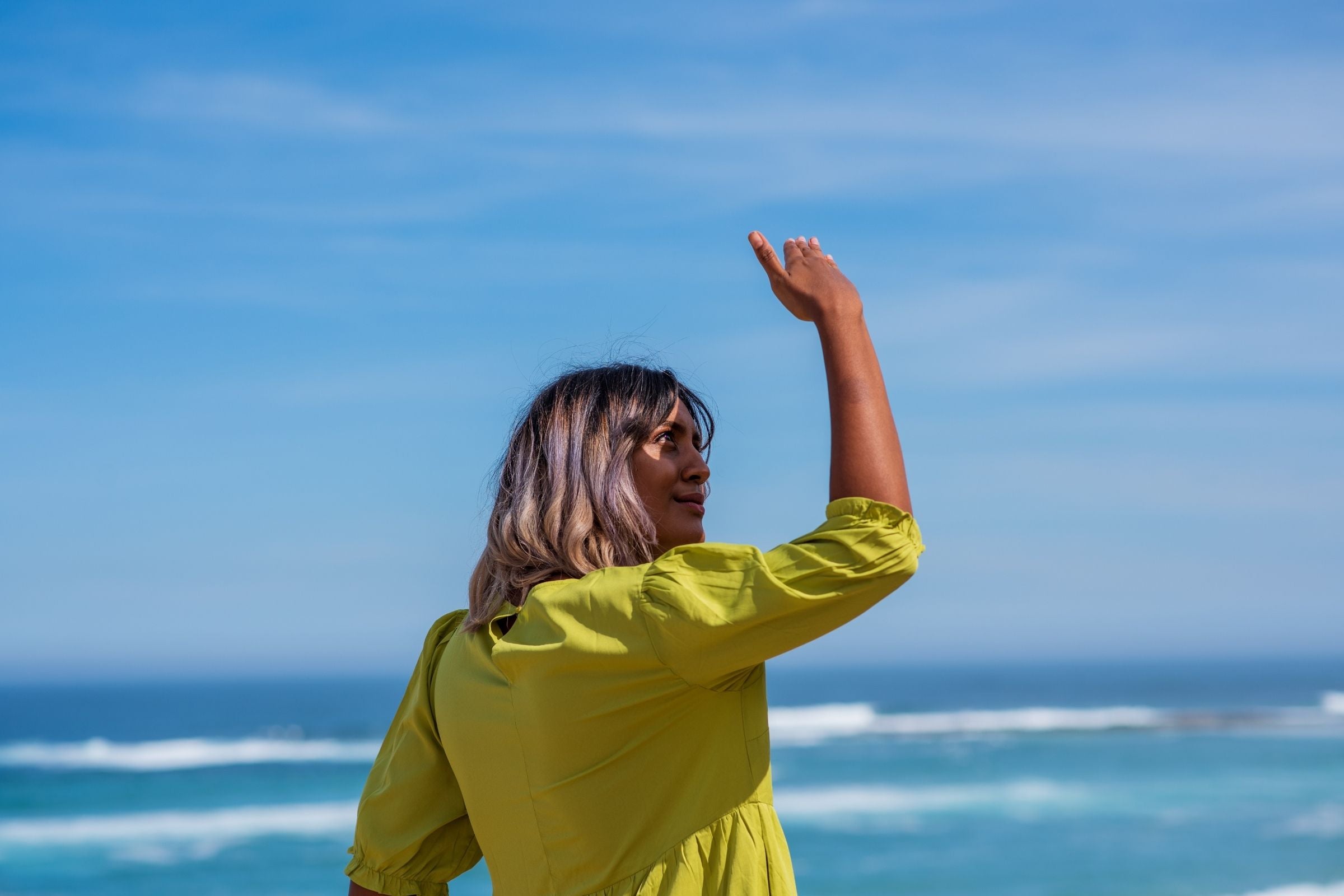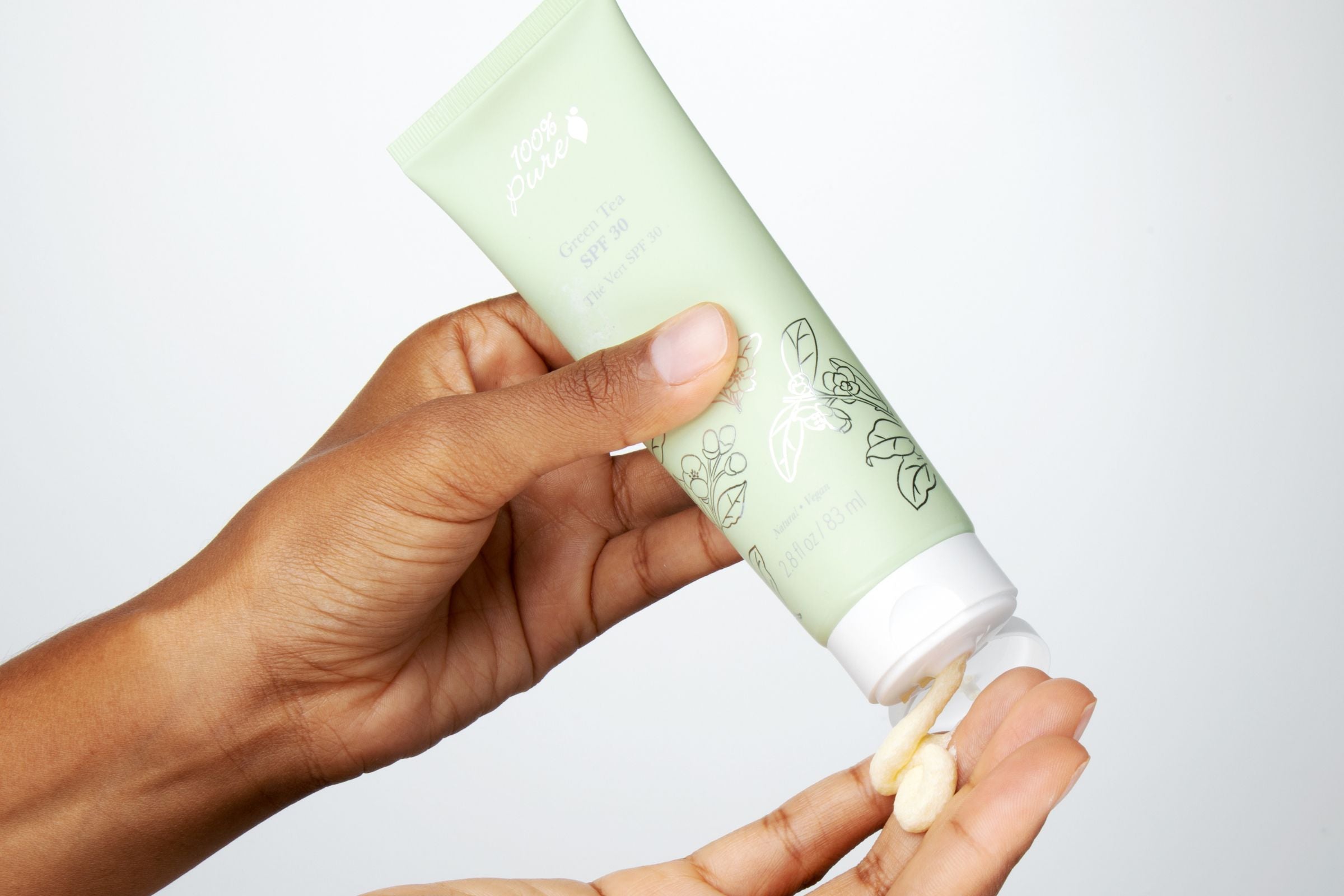Bask in the Sun’s Glory Safely!
Written by: 100% PURE®
As the cooler months breathe cool temps while the sun snoozes in its own warmth, you might find solace in one less skincare step – applying sunblock. Before you cluck your boots with glee and head out for a latte, there’s a latte you should know about UV rays; you can’t escape them.
We know it seems like an odd time of the year to focus on sunblocks, but skin needs protection year-round! While we’re into pumpkin spice and everything nice, we’re not into white residue, grease, and the potential harm of chemical UV filters in conventional sunscreens.
A great sunblock is only as good as what’s in it and how you use it. We have the goods on super sheer, plant-derived formulas, ready to protect you from UV assailants lurking during the Earth’s tilt. Let’s sweeten your latte and the perks of wearing sunblock daily to beat the fall blues and keep your complexion happy and healthy year-round!
Like a double-edged circle, that fiery ball in the sky provides a plethora of advantages – say, life on Earth wouldn’t exist - and health and skin disadvantages for us planet dwellers, who don’t regularly wear adequate sun protection. Sunscreen is meant to protect your skin from the sun’s harmful rays, and it’s hard to exaggerate how important this one product is for your delicate dermis.
Sunblock specifically shields your skin from the ultraviolet (UV) rays, which consist of UVA rays, which are most associated with premature, long-term aging of the skin, and UVB (burning) rays, which are attributed to sunburn. UVA light penetrates all levels of the skin, from the epidermis down to the dermis. This damaging light can affect the collagen and elastin fibers that keep your skin taut and elastic.
If UVB light reaches the epidermis; it can cause photoaging, damage DNA, and trigger the formation of precancerous cells as well as excess melanin production. Melanin is a pigment that’s meant to protect the skin from the sun’s rays, but it results in the appearance of dark spots, popped blood vessels in the skin, sunburns, premature aging, and an increased risk of skin cancer.
If you’ve been mindlessly applying conventional sunscreen for years, maybe it’s time to take a closer look at those chemical ingredients versus mineral ingredients in natural sunblocks.
Conventional sunscreen works by absorbing the sun’s UV rays with chemicals. That’s right, these chemicals are reacting with UV rays right on your skin’s surface, and are turned into heat that is then released from your skin. This can spell bad news for sensitive skin types. This chemical and heat reaction can also irritate skin and trigger the formation of dark spots or worse, these harmful chemicals can pose health risks. More on that below!
As opposed to chemical sunscreen, physical sunscreens work by physically blocking (instead of reacting with) UVA and UVB rays. You might also see it called ‘mineral sunscreen’ because it uses minerals like zinc oxide and titanium oxide as physical shields against UV rays. Because natural sunblocks shield your skin against UV rays, you can eliminate the potential of harmful chemical reactions and irritation – and a UV biggie, fewer health risks.

Most conventional sunscreens use chemical sunblocks. These will typically contain a combination of oxybenzone, avobenzone, octisalate, octocrylene, homosalate, and octinoxate. These chemical combinations can mimic hormones when absorbed into the bloodstream and interfere with the body’s endocrine system. They’re designed with “absorption enhancers” that make molecules small enough to enter your deepest epidermal layers. This points to various health risks, ranging from hormonal and thyroid disruption to increased risk of certain types of hormonal cancers.
The toxic traits of chemical UV filters don’t just stop at the potential for adverse skin and health risks. Another big baddie with the chemicals culprits in conventional sunblocks is how they affect the environment. That’s right! These chemical culprits cause harm to marine ecosystems and coral reefs. How so? Sunscreens don’t just stick to your skin when you jump into the ocean.
As you’re splishing and splashing around, your sunscreen is gradually slipping off your skin (that’s why you should always reapply after swimming). So where does that sunscreen go? Into the water you’re swimming in, of course! The runoff from chemical sunscreens we wear while swimming has damaged natural ecosystems and wildlife that live in oceans, rivers, and lakes. Each year, 6,000-14,000 tons of sunscreen enter the ocean, endangering and even killing delicate coral reef ecosystems.
Why risk the potential of skin and health adverse effects – plus harming Nemo or The Little Mermaid – when you can get an effective, wholesome alternative to chemical variants? Your health and the environmental implications are not worth it.
So, let’s sidestroke through the benefits of natural, mineral-based sunblocks for both healthy skin and happy sea life. They work by physically blocking (instead of reacting with) UVA and UVB rays. You might also see it called ‘mineral sunscreen’, because it uses minerals like zinc oxide and/or titanium oxide as physical shields against UV rays, instead of being absorbed into the skin. This eliminates the potential for harmful chemical reactions and irritation.
Believe it or not, mineral sunscreen can activate more quickly, as well. Since chemical sunscreens must absorb into the skin to be effective, they require up to 30 minutes to begin working, which means that you’ll need to wait before going into the water or being outside. Speaking of, swimming with natural sunblock on doesn’t damage natural ecosystems and aquatic life.
There’s quite a burden of responsibility on mineral sunblocks’ shoulders to protect our delicate dermis from harmful UVA and UVB rays, especially when it comes down to relying on either zinc oxide or titanium oxide. Let’s just say these minerals are natural at it.
Let’s look under the capes of these skin superheroes to see how they work, what powers they have to protect our skin, and why all skin types – even sensitive complexions – can benefit from their heroic abilities for skin and sun protection.
Zinc oxide is one mineral skin protectant that can be incredibly effective at keeping your epidermis shielded from UV rays. It’s derived from zinc, a naturally occurring element found in nature, which is combined with oxygen molecules and vaporized to create the final composition. Together, the elements produce a fine white powder, which when applied topically, coats the outer layer of your skin, protecting it from elemental stress and oxidative damage.
The result? We have an effective, naturally derived ingredient, which provides broad-spectrum protection from sunburns and a decreased risk of skin cancer. Another benefit of zinc oxide is it’s safe to use on photosensitive and sensitive skin. Natural sunscreens made with zinc oxide as their key sunblock ingredient are also considered reef-safe!
Titanium dioxide is another skin-loving mineral option that can sometimes be found paired with zinc oxide in natural sunblock formulas. But before titanium dioxide is made into sunscreens, it is first micronized. And after the micronized process, titanium dioxide doesn’t penetrate the skin. That means that you’re getting all the sun protection benefits without the UV risks and burns.
As an active mineral ingredient, titanium dioxide sits on the outermost layer of your skin, providing a physical barrier that adequately protects against both UVA and UVB rays. However, if you plan on swimming in natural bodies of water, it’s best to avoid titanium dioxide since it isn’t considered reef-safe and has a tougher time biodegrading. Still, you’ll be just fine using sunscreens with natural titanium dioxide in the pool or during outdoor activities.
Newsletter Subscribe
for more blog updates and exclusive discounts

When it comes to our natural sunblocks, we go the extra mile. We’re not just protecting you from the sun. Our natural sunscreens work full duty by keeping your skin youthful, protected, and hydrated with a powerful blend of plant-derived nutrients, oils, and vitamins. We include pure botanical elements in every one of our sunblocks, from green tea to tomato lycopene, to help address particular skin concerns.
The perfect percentage of zinc oxide and titanium dioxide means safe protection against harmful UVA and UVB rays. All our natural sunblocks are noncomedogenic, and fragrance and preservative-free, so you can wear them under or over makeup and reapply them throughout the day, without worrying about clogging your pores or irritating your skin type.
This natural sunblock pulls double duty, with its protective and anti-aging properties of green tea, plus powerful antioxidant benefits from vitamin E to neutralize free radicals and environmental damage. Made in a base of hydrating aloe and skin-soothing cucumber juice, with nourishing oils of raspberry, avocado, olive, and rosehip to soften and moisturize skin for comfortable all-day wear and sun protection.
Protection: SPF 30
Vegan: Yes
Contains Titanium Dioxide: No
Water Resistant: Yes
Type of Formula: Lotion
Find your perfect mate with this lightweight mist made with nourishing yerba mate. Like our fave green tea, yerba mate leaf is antioxidant-rich for protection against free radicals that cause UV damage and signs of premature aging. Safflower seed oil has a light floral scent that also soothes and conditions your skin. This reef-safe natural sunscreen spray has an application that’s easy to apply on the fly, and we use a compressed air canister built into the bottle to eject the formula, instead of ozone-harming CFCs.
Protection: SPF 30
Vegan: Yes
Contains Titanium Dioxide: No
Water Resistant: Yes
Type of Formula: Spray
Using sunblock properly is a must for dodging serious side effects like burnt skin, dark spots, and skin cancer. Whether it’s sizzling hot or cloudy days, fall or winter, be sure to use sun protection. Our natural sunscreens will provide the sun protection and skin nourishment you’ll need year-round, to ensure you’re enjoying super-safe fun outdoors. But there are some important tips to maximize your protection.
Protective Measures: You’ll need to follow a strict sunscreen regimen anytime your plans include being outdoors. That means wearing at least an SPF 30 even on cloudy days, reapplying after swimming and sweating, and reapplying again at least every 2 hours. Don’t forget key areas of the body to apply sun protection. And of course, don’t forget UV protective sunglasses, a wide-brimmed hat, an umbrella, and protective clothing for extra protection from the sun!
Daily Routine with SPF: Layering sunblock with other natural skincare products in your daily routine is easy and can provide maximum skin-efits for your skin. Here's how to integrate our natural sunblocks into your regimen, along with some tips on combining them with other skincare products:
Step 1: Cleanse your skin: Start by using a gentle cleanser like the 100% PURE Bakuchiol Cleanser to remove dirt, oil, and impurities from your skin as well as stimulate cellular turnover for a smoother complexion. Gently massage it onto damp skin, then rinse with lukewarm water and pat dry.
Step 2: Tone (optional): If you typically use a toner in your routine, try applying the 100% PURE Flower Water Toner after cleansing to balance your skin's pH levels. This step is optional but can be beneficial for some individuals.
Step 3: Serum: If you’re looking for the perfect base for flawless makeup application, our Black Tea Grass Jelly Anti-oxidant Serum is formulated with bakuchiol and Puerh Black Tea Leaves, which combats free radical damage that causes signs of aging. Grass jelly is a reparative concoction of hydrating plant saccharides and super soothing tiger grass, while concentrated antioxidants help plump and firm with an anti-aging effect.
Step 4: Moisturize: If you like the serum packed with the benefits of black tea and grass jelly, you’ll love pairing it with our Black Tea Grass Jelly Anti-oxidant Moisturizer! Formulated to sink deep into the skin, this moisturizer combats signs of aging by nourishing skin with powerful hydration and beneficial antioxidants so skin looks firmer, brighter, and more youthfully radiant.
Step 5: Eye cream: Our fan-favorite Coffee Bean Caffeine Eye Cream features anti-inflammatory, caffeine-rich green tea and coffee to de-puff while increasing circulation to brighten dark circles. Concentrated with potent anti-aging vitamins and antioxidants to awaken the eye area, and nourishing rosehip oil for softer, more youthful skin around the eyes.
Step 6: Sunblock: At any time of day and any season, it's crucial to protect your skin from harmful UV rays. Finish off your routine by applying a broad-spectrum sunscreen with at least SPF 30. Sunscreen helps prevent sun damage, wards off premature aging, and most importantly, reduces your risk of skin cancer.
PRO-TIP: If your skincare routine contains a retinol product used at night, it’s especially crucial to use a sunblock the next day. Retinol makes skin extra sensitive to the sun, which could exasperate photosensitivity, sunburns, and sun damage. We have an amazing, natural, plant-based alternative to retinol known as bakuchiol, which features skin-loving ingredients sans the sensitivity markers to the sun.
How often should I reapply natural sunblock?
Natural sunblock is, unfortunately, not effective all day long and will degrade (break down and become less effective) the longer you wear it. A best practice is to apply it every 90 minutes to 2 hours, at least 15-30 minutes before going outside. If you’re swimming or sweating, reapply it immediately after rinsing off or towel-drying. You’ll need to follow a strict sunscreen regimen anytime your plans include being outdoors. That means wearing at least an SPF 30 even on cloudy days, reapplying after swimming and sweating, and reapplying again at least every 2 hours
Is there a difference between sunblock and sunscreen?
Most sunscreens only cover UV-B rays. Sunblock physically blocks the sun's UV rays from penetrating the skin, acting as a barrier. Sunblocks contain either zinc oxide or titanium dioxide and protect the skin against both UVA and UVB rays.
Can I use body sunblock on my face?
Absolutely! While body sunblock can be used on the face, it's essential to know the differences. Facial sunblocks are typically formulated to be lighter, non-comedogenic (meaning they won't clog pores), and may contain ingredients beneficial for delicate facial skin. However, if you're in a pinch, a body sunblock can provide protection. Just ensure it's broad-spectrum, and if you have sensitive or acne-prone skin, it's wise to choose a product specifically designed for the face to minimize potential breakouts or irritation.
How can I remove mineral sunblocks effectively without clogging my pores?
Mineral sunblocks, also known as physical sunscreens, use ingredients like zinc oxide and titanium dioxide to shield your skin from the sun's rays. They can be a bit more challenging to remove than their chemical counterparts. To effectively cleanse without clogging your pores:
- Double Cleanse: Start with an oil-based cleanser or a dedicated makeup remover. This helps dissolve the mineral particles and any other sunscreen residues.
- Follow with a gentle water-based cleanser. This will ensure that any leftover product and oil from the first cleanse are removed.
- Use lukewarm water, as very hot water can strip the skin of its natural oils.
- Always moisturize after cleansing to maintain your skin's hydration and barrier function.
Are natural sunblocks safe for children and during pregnancy?
Natural sunblocks, often referring to mineral-based formulas, are a popular choice for many, including children and pregnant individuals. They offer protection by creating a physical barrier on the skin, reflecting the sun's rays.
For children: Mineral sunblocks are often recommended for babies and toddlers since they're less likely to cause skin irritations compared to chemical sunscreens. Always check the label for age recommendations and ensure the product is specifically formulated for children's sensitive skin.
For pregnancy: Mineral sunblocks are commonly considered safe during pregnancy. They lack certain chemical filters found in chemical sunscreens, which some prefer to avoid during pregnancy. However, always consult with a healthcare professional before making a choice and read the product's label to ensure it's free from any potentially harmful ingredients.
Remember, regardless of the type of sunscreen, it's crucial to apply generously and reapply every two hours or immediately after swimming or sweating for optimal sun protection.
- Tags: October-2023, Skin Care, skincare
We carefully hand-select products based on strict purity standards, and only recommend products we feel meet this criteria. 100% PURE™ may earn a small commission for products purchased through affiliate links.
The information in this article is for educational use, and not intended to substitute professional medical advice, diagnosis, or treatment and should not be used as such.













